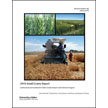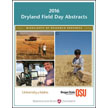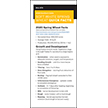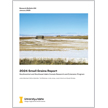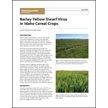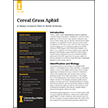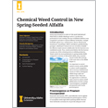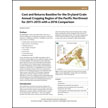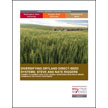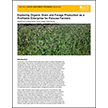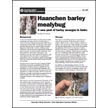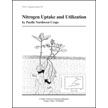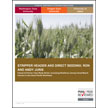Cereals
2007 North-Central Idaho Crop Management Trials
Summarizes field agronomic performance evaluations conducted in northern Idaho during 2007, including a demonstration trial of safflower yield, an herbicide response study with Clearfield wheat, an...
Presents the results of variety performance trials conducted during the 2006-07 season at sites from Craigmont to Bonners Ferry. Varieties of winter wheat, spring wheat, spring barley and spring...
2007 Small Grains Report: Southcentral and Southeast Idaho Cereals Research & Extension Program
Presents the results of variety performance trials established at four locations for winter varieties and five locations for spring varieties in southcentral and southeastern Idaho during the fall...
Summarizes the performance of winter wheat, spring wheat, spring barley, spring pea, lentil and chickpea cultivars tested in trials conducted in Idaho, Lewis, Nez Perce, Latah and Boundary counties...
2008 Small Grains Report: Southcentral and Southeastern Idaho Cereals Research and Extension Program
The 2008 annual report of the southcentral and southeastern Idaho cereals research and extension program provides 2008 agronomic data for hard and soft white winter wheats; hard and soft white...
Summarizes the performance of winter wheat, spring wheat, spring barley, spring pea, lentil and chickpea cultivars tested in trials conducted at 11 test sites in Idaho, Lewis, Nez Perce, Latah and...
The annual report of the southcentral and southeastern Idaho cereals research and extension program provides 2009 agronomic data for hard and soft white winter wheats; hard and soft white spring...
Summarizes the performance of winter wheat, spring wheat, spring barley, spring pea, lentil and chickpea cultivars tested in trials conducted in Idaho, Lewis, Nez Perce, Latah and Boundary counties...
2011 Small Grain and Grain Legume Report
From the Idaho Small Grain and Grain Legume Research and Extension Program at the University of Idaho comes this summary of the performance of winter wheat, spring wheat, spring barley, spring pea,...
2011 Small Grains Report: Southcentral and Southeastern Idaho Cereals Research and Extension Program
The annual report of the southcentral and southeastern Idaho cereals research and extension program provides 2011 agronomic data for hard and soft white winter wheats; hard and soft white spring...
2012 Small Grain and Grain Legume Report
Summarizes the performance of winter wheat, spring wheat, winter barley, spring barley, dry pea, lentil and chickpea cultivars tested in trials conducted at eight test sites in Lewis, Nez Perce,...
2012 Small Grains Report: Southcentral and Southeastern Idaho Cereals Research and Extension Program
The annual report of the southcentral and southeastern Idaho cereals research and extension program provides 2012 agronomic data for hard and soft white winter wheats; hard and soft white spring...
Summarizes the performance of winter wheat, spring wheat, winter barley, spring barley, dry pea, lentil and chickpea cultivars tested in trials conducted at eight test sites in Lewis, Nez Perce,...
2013 Small Grains Report: Southcentral and Southeastern Idaho Cereals Research and Extension Program
The annual report of the southcentral and southeastern Idaho cereals research and extension program provides 2013 agronomic data for hard and soft white winter wheats; hard and soft white spring...
Summarizes the performance of winter wheat, spring wheat, winter barley, spring barley, dry pea, lentil and chickpea cultivars tested in trials conducted at 12 test sites in Lewis, Nez Perce,...
2014 Small Grains Report: Southcentral and Southeastern Idaho Cereals Research and Extension Program
The annual report of the southcentral and southeastern Idaho cereals research and extension program provides 2014 agronomic data for hard and soft white winter wheats; hard and soft white spring...
Summarizes the performance of winter wheat, spring wheat, winter barley, spring barley, dry pea, lentil and chickpea varieties tested in trials conducted at 10 test sites in Lewis, Nez Perce,...
2015 Small Grains Report: Southcentral and Southeastern Idaho Cereals Research and Extension Program
The annual report of the south-central and southeastern Idaho cereals research and extension program provides 2015 agronomic data for hard and soft white winter wheats; hard and soft white spring...
2016 Dryland Field Day Abstracts
This publication is a compilation of the 2016 abstracts from dryland field days for Washington State University Extension, University of Idaho Extension and Oregon State University Extension.
2016 Small Grains Report: Southcentral and Southeastern Idaho Cereals Research and Extension Program
The annual report of the south-central and southeastern Idaho cereals research and extension program provides 2016 agronomic data for hard and soft white winter wheats; hard and soft white spring...
This report summarizes the performance of winter wheat, spring wheat, winter barley, spring barley, winter pea, spring pea, lentil and chickpea varieties tested in extension variety trials...
2017 Small Grains Report: Southcentral and Southeastern Idaho Cereals Research and Extension Program
The annual report of the south-central and southeastern Idaho cereals research and extension program provides 2017 agronomic data for hard and soft white winter wheats; hard and soft white spring...
This report summarizes the performance of winter wheat, spring wheat, winter barley, spring barley, winter pea, spring pea, lentil and chickpea varieties tested in Extension variety trials...
2018 Small Grains Report: Southcentral and Southeast Idaho Cereals Research and Extension Program
Summary of University of Idaho research done during the 2018 growing season on wheat and barley varieties in numerous locations in southcentral Idaho and southeast Idaho. Includes planting rates...
2020 Small Grains Report: Southcentral and Southeast Idaho Cereals Research and Extension Program
Summary of University of Idaho research done during the 2020 growing season on wheat and barley varieties in numerous locations in southcentral Idaho and southeast Idaho. Includes planting rates...
2020 Southern Idaho Hard Winter Wheat Quick Facts
This two-page fact sheet offers recommendations for growing hard winter wheat in southern Idaho, with pointers or information on growth and development, rotation and seeding, fertilization,...
2020 Southern Idaho Soft White Spring Wheat Quick Facts
This two-page fact sheet offers recommendations for growing soft white spring wheat in southern Idaho, with pointers or information on growth and development, rotation and seeding, fertilization,...
2020 Southern Idaho Soft White Winter Wheat Quick Facts
This two-page fact sheet offers recommendations for growing soft white winter wheat in southern Idaho, with pointers or information on growth and development, rotation and seeding, fertilization,...
2021 Small Grains Report: Southcentral and Southeast Idaho Cereals Research & Extension Program
Packed with tons of agronomic data, disease ratings and end-use quality data — interspersed with reports about planting and weather conditions, insect and diseases issues and more — this 160-page...
2022 Small Grains Report: Southcentral and Southeast Idaho Cereals Research & Extension Program
Packed with tons of agronomic data, disease ratings and end-use quality data — interspersed with reports about planting and weather conditions, insect and diseases issues, and more — this 162-page...
Packed with tons of agronomic data, disease ratings and end-use quality data — interspersed with reports about planting and weather conditions, insect and diseases issues and more. This 146-page...
Packed with tons of agronomic data, disease ratings and end-use quality data — interspersed with reports about planting and weather conditions, insect and diseases issues and more. This 162-page...
Adopting Quinoa in Southeastern Idaho
This is a comprehensive guide to what's known about growing quinoa in southeastern Idaho, including environmental requirements, seeding, fertility and water requirements, pest control, harvesting...
Advances in Dryland Farming in the Inland Pacific Northwest (REACCH Handbook)
Farmers make tough decisions all the time — it comes with the territory. When that territory includes the dryland region of the inland Pacific Northwest, decisions can be even more challenging.
Agronomic Zones of the Dryland Pacific Northwest
With an annual wheat harvest valued at $2.1 billion, producers in Idaho, Oregon and Washington know the value of farming practices adapted to each region, county and field. Researchers mapped...
The alfalfa leafcutting bee is a vital pollinator for multiple cropping systems, including alfalfa, canola, melons and carrots. This information card provides basic facts about and photographs of...
Back to Basics: Hedging and Basis in Grain Marketing
Basis in grain marketing refers to the difference between cash and futures prices. Having a solid understanding of it and its seasonal patterns is crucial to any successful marketing plan. Learn...
Barley Thrips Biology and Control
The barley thrips is a pest in Idaho that has caused economic damage in barley crops. This publication covers the damage, description, distribution and biology of barley thrips as well as treatment...
Barley Yellow Dwarf Virus in Idaho Cereal Crops
Describes the symptoms, method of spread and control measures for barley yellow dwarf, a viral disease spread by aphids. Color photos. Authors: Juliet M. Marshall, Arash Rashed 4 pages
Best Management Practices For Managing Herbicide Resistance
Herbicide resistance is a problem that has quickly spread throughout wheat-growing regions of the inland Pacific Northwest. This timely PNW publication offers best management practices (BMPs) for...
Biodiesel in the Pacific Northwest
With world demand for green energy sources growing exponentially, alternative fuel is definitely a market worth knowing more about. Biodiesel, an alternative fuel produced from fats like vegetable...
Biosolids in Dryland Cropping Systems
This publication reviews the long term benefits of municipal biosolids applications on soil health in dryland cereal and pasture cropping systems east of the Cascades. Biosolids were an especially...
Bitterroot Soft White Winter Wheat
This four-page publication covers the history, description, agronomic performance, milling and baking quality, and disease reactions of this new variety of wheat. Authors: Juliet Windes, Chad...
Buckwheat Production West of the Cascades
Naturally gluten-free, buckwheat has a variety of culinary uses regionally and internationally. Learn about market opportunities, how to establish a strong stand, and the best management and...
Cereal Cyst Nematodes: Biology and Management in Pacific Northwest Wheat, Barley, and Oat Crops
Cereal cyst nematodes reduce yields of wheat, barley and oats in the Pacific Northwest states of Idaho, Oregon and Washington. It is estimated that these pests reduce wheat profitability in these...
Cereal Grass Aphid: A Newly Invasive Pest in North America
Cereal grass aphid is a newly invasive aphid pest in North America. It colonizes cultivated crops like wheat, barley and oat, sucking their juices and using them as host sites for reproduction,...
A pest of small grains, the cereal leaf beetle now occurs in 29 Idaho counties. Learn about its host plants, appearance, life cycle, damage and control recommendations. Five color photographs...
Changing Idaho Feed Crop Supply and Demand—Implications
The number of animals in concentrated animal feeding operations has increased since the early 1990s. The upsurge has influenced the supply and demand for crops used as feed, like alfalfa hay,...
Charles Two-Row Winter Malt Barley
Charles barley is the first winter malt type barley accepted by the American Malting Barley Association (AMBA) as having adequate malt quality and brewing characteristics. This four-page...
Chemical Weed Control in New Spring-Seeded Alfalfa
Weed management is one of the most important practices in alfalfa production, particularly in new seeding. This bulletin briefly discusses two chemical-based approaches: preemergence or preplant...
Ron Jirava's approach to conservation tillage helps his farm to remain economically viable. Learn more in this farmer-to-farmer case study. Authors: Georgine Yorgey, Kristy Borrelli, Kathleen...
Controlling Root and Crown Diseases of Small Grain Cereals
This publication describes practices to manage and minimize losses from root and crown diseases of wheat and barley throughout the Pacific Northwest. Authors: Richard Smiley, Timothy Paulitz, Juiet...
How do growers know what to grow or what will be profitable for their operation? This publication provides benchmark estimates for farm-level costs and returns for the dryland crops typically...
Crop Yield in Barley-Pulse Intercropping Systems under Well-Watered and Drought-Stressed Conditions
Idaho leads the nation in barley production, even though eastern Idaho (the state’s largest contributor) receives very little annual precipitation. Applying shrewd irrigation management practices...
Steve and Nate Riggers use an innovative approach to dryland farming systems. Learn more in this publication, part of the Farmer-to-Farmer Case Study project. Authors: Georgine Yorgey, Kristy...
Estimating Water Requirements of Hard Red Spring Wheat for Final Irrigations
This publication teaches how to use the soil "feel and appearance method" and information on crop stage and soil type to determine whether and how much to irrigate. Authors: Roger Ashley, Larry...
Estimation of Wheat Yield and Grain Protein with Handlheld and UAV-Mounted Sensors
Wheat grain protein levels depend on efficient uptake of nitrogen (N) — without it, optimized wheat yields are not possible. Monitoring your field’s N uptake is thus crucial. Using crop sensors to...
Exploring Organic Grain and Forage Production as a Profitable Enterprise for Palouse Farmers
Demand for organic grain has outpaced actual U.S. grain production in recent years. Yet little is known about organic grain production in the Palouse, likely because it comprises a small portion of...
Field Guide for Diagnosing Common Wheat Maladies of the Pacific Northwest
This field guide provides an overview of basic plant pathology concepts that are relevant to disease identification in wheat. It introduces tools to help distinguish between biotic and abiotic...
Grazed Cover Cropping, Drew Leitch (Farmer to Farmer Case Study Series)
An Inland Northwest farmer has been trialing spring and fall-seeded cover cropping for cow-calf grazing and the effects on the following grain crops. Authors: Georgine Yorgey, Kristy Borrelli,...
Haanchen Barley Mealybug: A New Pest of Barley Emerges in Idaho
A new pest in at least four varieties of barley, the Haanchen barley mealybug, was found for the first time in southern Idaho's Bingham, Bonneville, Caribou, Jefferson and Madison counties in 2003.
Harvest Weed Seed Control: Applications for PNW Wheat Production Systems
This publication discusses the various HWSC systems and their potential suitability for PNW wheat production systems across rainfall regions. Authors: Drew Lyon, Michael Walsh, Judit Barroso, Joan...
Idaho Spring Barley Production Guide
Barley is one of Idaho’s most important crops. Although its harvested acreage has decreased in the past twenty years, the state is still the nation’s top barley producer. Published in 2003, this...
Integrated Management of Downy Brome in Winter Wheat
Downy brome ( Bromus tectorum L. ), also known as cheatgrass, is especially troublesome in low precipitation production areas where crop rotations are mostly limited to winter wheat followed by a...
Integrated Management of Feral Rye in Winter Wheat
Feral rye ( Secale cereale L.), also known as volunteer rye, is a troublesome weed in winter wheat production in the low and intermediate rainfall zones of eastern Washington, Oregon and southern...
Integrated Management of Mayweed Chamomile in Wheat and Pulse Crop Production Systems
In small grain and pulse crops throughout the high rainfall zones of the Inland Pacific Northwest, mayweed chamomile is a troublesome weed. Individual plants can produce as many as 17,000 seeds,...
Integrated Management of Mustard Species in Wheat Production Systems
Blue mustard, flixweed and tumble mustard can be a headache to control when it comes to winter wheat; this article shows you how it can be done. Authors: Drew Lyon, Ian Burke, Joan Campbell 9 pages
Integrated Management of Prickly Lettuce in Wheat Production Systems
Prickly lettuce is a common weed in wheat production systems throughout the PNW, but it's difficult to manage. Herbicides can control prickly lettuce in wheat, but many biotypes have developed...
Integrated Management of Wild Oat in the Pacific Northwest
In the Pacific Northwest (PNW), wild oat has become a notable weed pest of small grain and rotational crops, including pulse crops, potato, sugar beet and oilseed crops. It has infested more than 3...
Integrated Pest Management for the Wheat Head Armyworm Complex in the Pacific Northwest
The wheat head armyworm complex is comprised of two armyworm species, Dargida diffusa (Walker) and Dargida terrapictalis (Buckett), which caused recent and sporadic damage to cereal crops in the...
Integrated Pest Management of Cutworms
Insect and disease pests are prevalent in both residential and commercial food production settings, meaning that a large number of Idahoans contend with them each year. Part of an integrated pest...
Irrigation and Nitrogen Fertilization Affect End-Use Quality of Spring Wheat of Three Market Classes
Water and nitrogen are key ingredients in successful cropping systems, particularly in the challenging climates of the semiarid and arid regions of the western United States. This publication...
Italian Ryegrass Management in Inland Pacific Northwest Dryland Cropping Systems
Widespread herbicide resistance in Italian ryegrass makes integrated weed management strategies difficult for this problematic weed. Learn about the multiple control methods and their combination...
Karnal bunt or partial bunt is a fungal disease of wheat, durum wheat, rye and triticale. This publication includes information on the history, impact, symptoms, disease cycle and control of karnal...
Management Strategies for Preventing Herbicide-Resistant Grass Weeds in Clearfield Wheat Systems
Based on computer modeling, the publication describes herbicide rotation strategies aimed at preventing the buildup of herbicide-resistant grass weeds (downy brome, jointed goatgrass and wild oat)...
Marketing Strategies for Idaho Wheat Producers: Identifying Top Performers
Grain markets have significantly changed over the past thirty years, but many wheat growers still rely solely on the elevator quote at harvest time. Discover a better approach in this study of the...
Nitrogen Uptake and Utilization by Pacific Northwest Field Crops
This publication is geared to promoting an understanding of the timing and pattern of biomass accumulation and nitrogen (N) uptake for crops in the Pacific Northwest. Proper use of N-based...
Northern Idaho Fertilizer Guide: Oats
Fertilizer improves plant growth and productivity. An entry in the northern Idaho Fertilizer Guide series, this four-page publication offers fertilizer guidelines for nitrogen, phosphorus,...
Northern Idaho Fertilizer Guide: Soft White Spring Wheat
Fertilizer improves plant growth and productivity. An entry in the northern Idaho Fertilizer Guide series, this four-page publication offers fertilizer guidelines for nitrogen, phosphorus,...
Northern Idaho Fertilizer Guide: Spring Barley
Fertilizer improves plant growth and productivity. An entry in the northern Idaho Fertilizer Guide series, this four-page publication offers fertilizer guidelines for nitrogen, phosphorus,...
Northern Idaho Fertilizer Guide: Spring Canola
Fertilizer improves plant growth and productivity. An entry in the northern Idaho Fertilizer Guide series, this four-page publication offers fertilizer guidelines for nitrogen, phosphorus,...
Northern Idaho Fertilizer Guide: Winter Barley
Fertilizer improves plant growth and productivity. An entry in the northern Idaho Fertilizer Guide series, this four-page publication offers fertilizer guidelines for nitrogen, phosphorus,...
Northern Idaho Fertilizer Guide: Winter Rapeseed
Fertilizer improves plant growth and productivity. An entry in the northern Idaho Fertilizer Guide series, this four-page publication offers research-based fertilizer guidelines for nitrogen,...
Northern Idaho Fertilizer Guide: Winter Wheat
Fertilizer improves plant growth and productivity. An entry in the northern Idaho Fertilizer Guide series, this four-page publication offers fertilizer guidelines for nitrogen, phosphorus,...
Optimum Nitrogen Rates for Wheat Depend on the Environment and Field-Specific Conditions
Nitrogen is vital for crops — it is an essential nutrient whose efficient absorption makes high crop yields possible. Despite significant developments in wheat breeding and nutrient management,...
Organic Small Grain Production in the Inland Pacific Northwest: A Collection of Case Studies
Organic farming can be a challenge anywhere, but the obstacles encountered by Inland Pacific Northwest organic small grain farmers are unique. Their options for managing weeds and soil nutrients...
Performance of Hard Red Winter Wheat in Late-Planted Fallow
This publication describes results of field research on the performance of hard red winter wheat cultivars in a late-planted fallow system in the low-precipitation zone of Oregon and Washington.
Phosphorus Fertilization of Late-Planted Winter Wheat in No-Till Fallow
This publication describes results of applied research on phosphorus fertilization of late-planted winter wheat in no-till fallow in the low-precipitation zone of Oregon and Washington. Authors:...
Planting Dates in Wheat Production in Southern Idaho
This publication summarizes more than three decades of research into planting date in spring and winter wheat production in southwestern Idaho. Much of the information will be pertinent to other...
Potential of Silicon Amendment for Improved Wheat Production
Balanced mineral nutrition is essential to grow wheat successfully. Silicon (which helps to form silicate minerals) is the second most plentiful element on Earth, but its effect on plant growth and...
Root-lesion Nematodes: Biology and Management in Pacific Northwest Wheat Cropping Systems
Plant-parasitic root-lesion nematodes are microscopic parasites whose damage (which includes lesions and predisposing a plant to infection) is often difficult to identify. This 14-page publication...
Russian Thistle: Management in a Wheat-Fallow Crop Rotation
Russian thistle is the most economically important summer-annual broadleaf weed found in the low-precipitation zone of the inland Pacific Northwest. This weed causes serious management problems in...
Saving Energy and Fertilizer Costs: Best Management Practices for Southern Idaho Grain Producers
Rising energy costs mean harder choices for grain growers with each passing season. This publication describes the ways southern Idaho grain producers can streamline production practices to gain...
Scheduling the Final Irrigation for Wheat and Barley
Water management during grain formation is more important than ever, particularly with urban expansion and the subsequent increase in municipal water use. By investigating crop water-use patterns...
Sharp Eyespot Disease of Wheat and Barley
Sharp eyespot disease is fungal and infects wheat and barley in temperate world regions but also in all parts of Idaho. Its global incidence has increased in the past few decades. Because it can...
Southern Idaho Dryland Winter Wheat Production Guide
Wheat is an important crop throughout Idaho, especially in the dryland cropping areas of southern Idaho. However, the region's rolling landscape with high-wind and water-erosion potential plus low...
Southern Idaho Fertilizer Guide: Irrigated Winter Barley
Fertilizer improves plant growth and productivity. An entry in the southern Idaho Fertilizer Guide series, this four-page publication offers fertilizer guidelines for nitrogen, phosphorus,...
Southern Idaho Fertilizer Guide: Irrigated Winter Wheat
Fertilizer improves plant growth and productivity. An entry in the southern Idaho Fertilizer Guide series, this six-page publication offers fertilizer guidelines for nitrogen, phosphorus,...
Spring Barley Quick Facts (2023 Southern Idaho)
This two-page fact sheet offers recommendations for growing spring barley in southern Idaho, with pointers or information on growth stages and development, rotation and seeding, irrigation,...
Spring Hulless Food Barley Production Quick Facts
This two-page fact sheet offers recommendations for growing spring hulless food barley in southern Idaho, with pointers or information on nutrition, rotation and seeding, growth stages and...
Straw Removal Calculator Guide
Straw removal has become a widespread practice in dryland wheat production in the inland Pacific Northwest. Although straw harvest may provide short-run economic benefits, it also can incur hidden...
Stripper Header and Direct Seeding: Ron and Andy Juris (Farmer-to-Farmer Case Study Series)
Ron and Andy Juris farm in Bickleton, Washington, an area that receives about 8-12 inches of annual precipitation. In this 2017 publication, the third- and fourth-generation cereal farmers discuss...
Eric Williamson integrates direct seeding, strip tillage and raising cattle into his farm near George, Washington: learn more in this farmer-to-farmer case study. Authors: Georgine Yorgey, Kristy...
Take-All Disease of Wheat in Idaho
Take-all is a highly destructive fungal disease of cereals whose ability to infect multiple plant parts often results in a crop’s complete destruction. Mainly found in wheat, barley, rye and...
Variable Rate Nitrogen Application: Eric Odberg (Farmer-to-Farmer Case Study Series)
Eric Odberg farms near Genesee, Idaho, in an area receiving about 22 inches of precipitation annually. In this 2016 publication, the fourth-generation cereal-based farmer discusses his experiences...
Wheat Characteristics under Varied Irrigation and Nitrogen
Determining optimum water and nitrogen requirements is critical to improve the yield and quality of wheat grown in arid and semiarid regions of the western United States. Because wheat is an...
Wheat Export from the United States and from Columbia River Ports
Over the past fifteen years, a broader array of exporters has impacted global wheat trade. As a result, producers face increased competition. Nearly 80% of the nation’s wheat crop is exported...
Wheat streak mosaic virus Management in Idaho Cereals
Wheat streak mosaic virus (WSMV) is a serious disease that damages wheat production in Idaho. Transmitted by the wheat curl mite, WSMV infects winter and spring wheat and can also infect barley,...
Wireworms in Idaho Cereals: Monitoring and Identification
Wireworms are among the most destructive soil insect pests, particularly of potatoes, corn, cereals and carrots. Worse, their numbers are resurging in the Pacific Northwest and Montana. This...




















